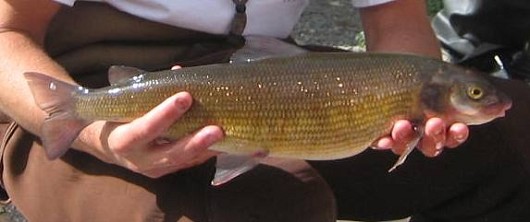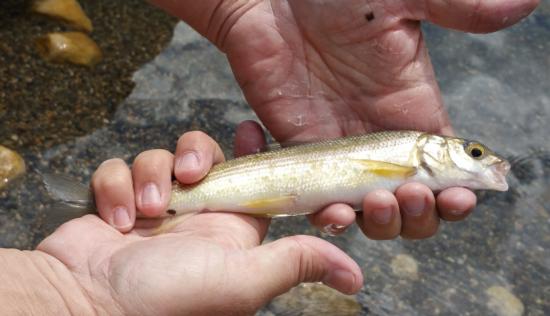Mountain Whitefish
-
Scientific NameProsopium williamsoni
-
NativeYes
-
Identification
 Mountain whitefish. Location: Lower Truckee River, NV. Date: Oct. 2007. Photo by Marianne Denton, Department of Natural Resources and Environmental Science, University of Nevada, Reno.
Mountain whitefish. Location: Lower Truckee River, NV. Date: Oct. 2007. Photo by Marianne Denton, Department of Natural Resources and Environmental Science, University of Nevada, Reno. Mountain Whitefish caught and released in Twin Lakes near Bridgeport, CA on 17 July, 2015. Photo and fish by Charles Baker
Mountain Whitefish caught and released in Twin Lakes near Bridgeport, CA on 17 July, 2015. Photo and fish by Charles Baker- Slim, cylindrical body, maximum 51 cm FL, (2.9kg)
- Adipose fin present, large scales, forked tail
- Short head, narrow snout overhangs mouth
- Small ventral mouth: no teeth
- Olive to dusky back, silvery body
- Juveniles: 7-11 dark parr marks
- Breeding males: nuptial tubercles on sides and head
- Fin rays: anal 11-13, pelvic 10-12, pectoral 14-18
- Lateral line scales: 74-90
-
Life History
Mountain Whitefish typically live in clear cold waters, and primarily at high elevations in California. Favorable habitat might include mountain lakes or mountain streams with deep pools (>1 m) where summer temperatures range from 11-21°C. Mountain Whitefish are found in Lake Tahoe where they swim in schools of 5-20 fish and occupy relatively deep water. Mountain Whitefish generally use their ventral mouth to feed on bottom dwelling insects in both streams and lakes. They may use their tail or fins to stir up prey from the substrate. Mountain Whitefish increase the diversity of their diet as they grow and tend to feed on the most abundant food organisms. Juvenile Mountain Whitefish in one stream may feed on mayfly, blackfly, and chironomid midges, while in another stream they may focus on mayfly and caddisfly larvae. In Lake Tahoe Mountain Whitefish eat a wide variety of bottom oriented invertebrates. Peak feeding occurs at dawn and dusk, though some whitefish may feed on terrestrial insects during daylight hours. Growth in Mountain Whitefish is variable, though generally growth rates are greater in large low-elevation streams than in small alpine lakes. Mountain Whitefish reach sexual maturity in 2-4 years and spawning occurs between October and early December when water temperatures are below 11°C. Migration to favorable spawning gravels may be a short trip to a riffle or might include movement from a lake up into a small tributary. Large groups of Mountain Whitefish gather above rocky or gravelly substrate at night when females release an average of 5,500 eggs. The fertilized eggs fall into the spaces between the gravel and rocks and the eggs hatch in 6-10 weeks. The hatchlings are carried downstream to slower backwater areas. When the fry grow larger they move into deeper and faster water. In lakes young fry hide under aquatic vegetation.
-
Links to Other ResearchN / A

